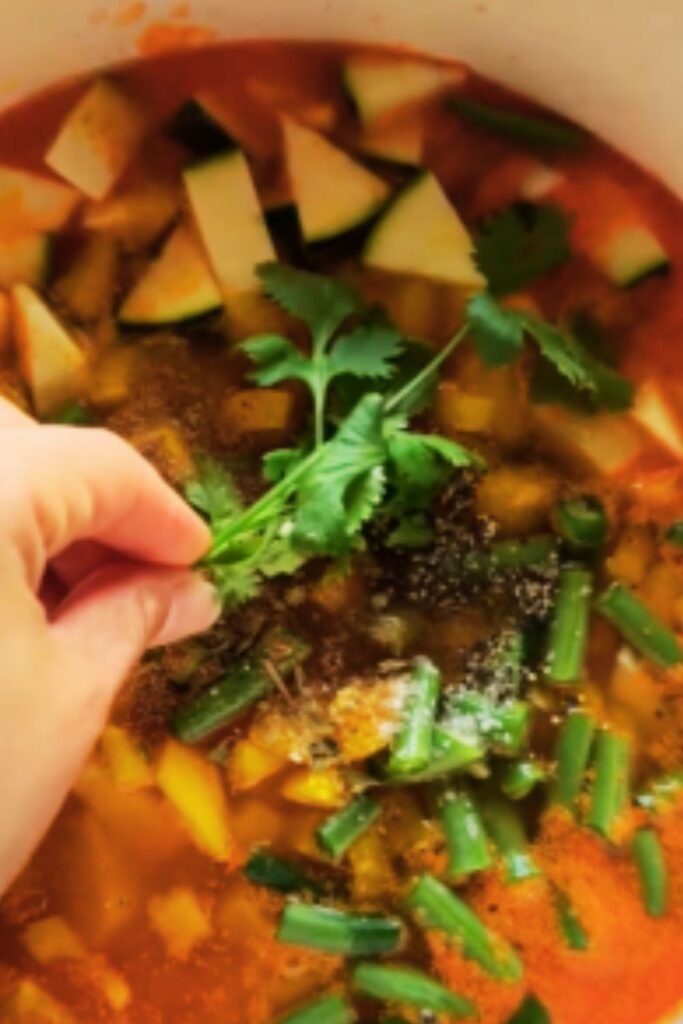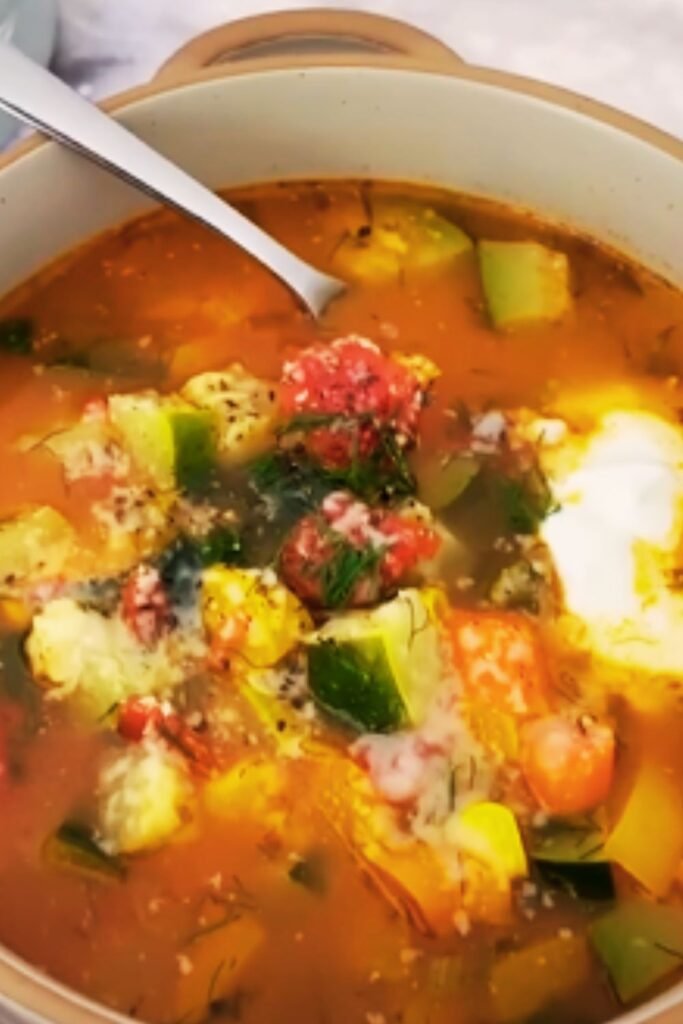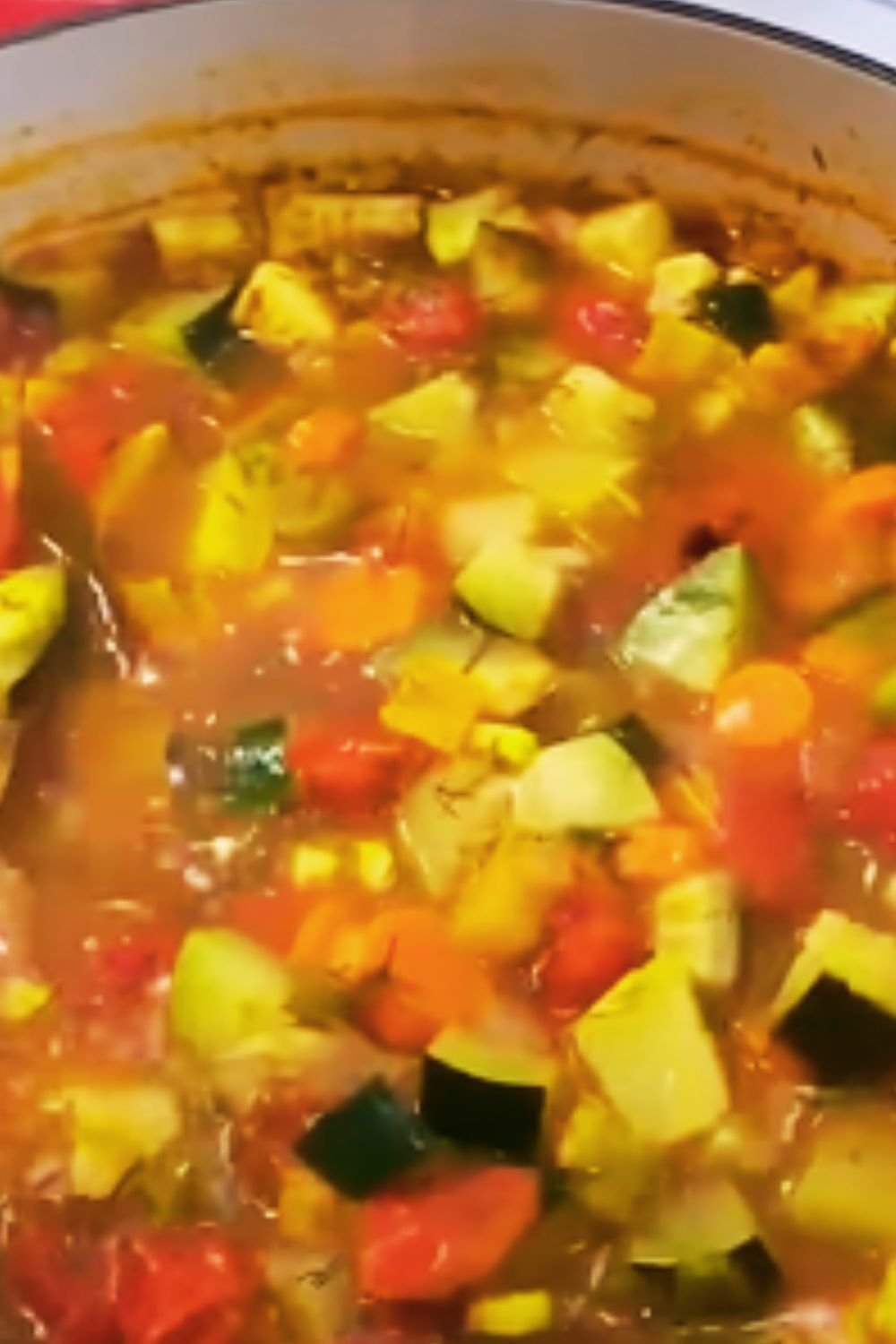There’s nothing quite like a steaming bowl of homemade vegetable soup on a chilly day. It’s the ultimate comfort food that somehow manages to be both nourishing and soul-satisfying. After years of tweaking and perfecting my recipe, I’m thrilled to share what I genuinely believe is the best vegetable soup you’ll ever make.
This isn’t just any vegetable soup—it’s a vibrant, flavorful pot of goodness packed with seasonal vegetables, herbs, and a perfectly seasoned broth that will have everyone coming back for seconds. Whether you’re looking for a healthy lunch option, a light dinner, or meal prep for the week ahead, this recipe has got you covered.
Why You’ll Love This Vegetable Soup
Before diving into the recipe, let me tell you why this vegetable soup stands out from the rest:
- Customizable: Use whatever vegetables you have on hand or are in season
- Nutrient-dense: Packed with vitamins, minerals, and fiber
- Budget-friendly: Makes use of affordable ingredients
- Meal-prep friendly: Tastes even better the next day and freezes beautifully
- Wholesome comfort: Satisfying without being heavy
- Family-approved: A hit with both kids and adults alike
I’ve made this soup countless times, and it’s become my go-to recipe when I need something healthy but comforting. The secret lies in building layers of flavor—starting with sautéing aromatic vegetables, adding high-quality broth, and finishing with fresh herbs.
Ingredients You’ll Need

For the base soup (serves 6-8):
- 2 tablespoons olive oil
- 1 large onion, diced
- 3 carrots, peeled and diced
- 3 celery stalks, diced
- 4 garlic cloves, minced
- 2 medium potatoes, diced (I prefer Yukon Gold)
- 1 medium zucchini, diced
- 1 cup green beans, trimmed and cut into 1-inch pieces
- 1 red bell pepper, diced
- 1 cup corn kernels (fresh or frozen)
- 1 cup peas (fresh or frozen)
- 1 can (14.5 oz) diced tomatoes, undrained
- 8 cups vegetable broth (low-sodium preferred)
- 2 bay leaves
- 1 teaspoon dried thyme
- 1 teaspoon dried oregano
- 1/2 teaspoon dried rosemary
- Salt and pepper to taste
- 2 tablespoons fresh parsley, chopped
- 1 tablespoon fresh lemon juice
Optional add-ins for extra protein:
- 1 can (15 oz) white beans, drained and rinsed
- 2 cups cooked quinoa or barley
- 2 cups chopped leafy greens (spinach, kale, or Swiss chard)
Equipment You’ll Need
- Large Dutch oven or soup pot (at least 6-quart capacity)
- Sharp chef’s knife
- Cutting board
- Measuring cups and spoons
- Wooden spoon or heat-resistant spatula
- Ladle for serving
Step-by-Step Instructions
Preparing Your Vegetables
First things first, proper preparation of your vegetables will make the cooking process smooth and enjoyable:
- Wash all vegetables thoroughly under cold running water
- Peel vegetables like carrots, onions, and garlic
- Cut all vegetables into uniform sizes (about 1/2-inch dice) to ensure even cooking
- Keep prepared vegetables separated as they’ll be added to the pot at different times
Making the Soup Base
- Heat olive oil in a large Dutch oven or soup pot over medium heat
- Add onions, carrots, and celery (the aromatic base known as “mirepoix”), and cook for 5-7 minutes until softened, stirring occasionally
- Add minced garlic and cook for another minute until fragrant
- Stir in potatoes and cook for 2 minutes
Adding the Remaining Ingredients
- Add zucchini, green beans, bell pepper, diced tomatoes with their juice, vegetable broth, bay leaves, thyme, oregano, and rosemary
- Season with salt and pepper (start with 1 teaspoon salt and 1/2 teaspoon pepper, adjust later to taste)
- Bring the soup to a boil, then reduce heat to maintain a gentle simmer
- Cover partially and cook for 20-25 minutes, or until the potatoes are tender
Finishing Touches
- Add corn and peas (and any optional add-ins like beans or greens) and simmer for an additional 5 minutes
- Remove bay leaves
- Stir in fresh parsley and lemon juice
- Taste and adjust seasoning as needed
Nutrition Facts
This vegetable soup isn’t just delicious—it’s also incredibly nutritious. Here’s the breakdown per serving (approximately 1.5 cups):
| Nutrient | Amount | % Daily Value* |
|---|---|---|
| Calories | 165 | – |
| Total Fat | 4g | 5% |
| Saturated Fat | 0.5g | 3% |
| Trans Fat | 0g | – |
| Cholesterol | 0mg | 0% |
| Sodium | 490mg | 21% |
| Total Carbohydrates | 28g | 10% |
| Dietary Fiber | 6g | 21% |
| Sugars | 9g | – |
| Protein | 5g | 10% |
| Vitamin A | – | 120% |
| Vitamin C | – | 75% |
| Calcium | – | 8% |
| Iron | – | 10% |
| Potassium | 685mg | 15% |
*Percent Daily Values are based on a 2,000 calorie diet. Your daily values may be higher or lower depending on your calorie needs.
With Optional Add-ins (Per Serving)
| Add-in | Additional Calories | Additional Protein |
|---|---|---|
| White beans (1/3 cup) | +75 calories | +5g protein |
| Cooked quinoa (1/3 cup) | +70 calories | +3g protein |
| Spinach (1 cup raw) | +7 calories | +1g protein |
| Kale (1 cup raw) | +7 calories | +1g protein |
Storage and Make-Ahead Tips
One of the best things about this soup is how well it keeps and how the flavors develop over time. Here’s how to make the most of your batch:
Refrigerator Storage
- Store in an airtight container in the refrigerator for up to 5 days
- The flavor actually improves after a day as the ingredients have time to meld together
Freezer Storage
- Cool soup completely before freezing
- Portion into freezer-safe containers, leaving about 1/2 inch of space at the top (soup expands when frozen)
- Freeze for up to 3 months
- Thaw overnight in the refrigerator before reheating
Reheating
- Stovetop: Reheat over medium-low heat, stirring occasionally
- Microwave: Heat in 1-minute intervals, stirring in between, until hot throughout
Serving Suggestions

This soup stands perfectly well on its own, but here are some delicious ways to serve it:
- With a slice of whole grain bread or a crusty baguette
- Topped with a sprinkle of freshly grated Parmesan cheese
- With a dollop of Greek yogurt for added creaminess
- Alongside a simple green salad for a complete meal
- In a bread bowl for a more substantial dinner
- With a squeeze of fresh lemon juice for brightness
- Topped with homemade croutons for added crunch
- With a drizzle of quality extra virgin olive oil
Recipe Variations
The beauty of this vegetable soup is its versatility. Here are some variations to try:
Seasonal Variations
| Season | Vegetable Swaps | Herb Suggestions |
|---|---|---|
| Spring | Asparagus, peas, leeks | Fresh dill, chives |
| Summer | Zucchini, yellow squash, fresh corn, tomatoes | Basil, parsley |
| Fall | Butternut squash, parsnips, turnips | Sage, thyme |
| Winter | Sweet potatoes, kale, cabbage | Rosemary, thyme |
International Flavors
- Italian Style: Add 1 teaspoon Italian seasoning, 1/4 cup tomato paste, and finish with grated Parmesan
- Mexican Style: Add 1 tablespoon cumin, 1 teaspoon chili powder, and serve with a squeeze of lime and chopped cilantro
- Mediterranean Style: Add olives, artichoke hearts, and a pinch of saffron, topped with fresh basil
- Asian Inspired: Use ginger instead of garlic, add bok choy, and finish with a dash of soy sauce and sesame oil
Dietary Adaptations
- Gluten-Free: The base recipe is already gluten-free! Just ensure your broth is certified gluten-free
- Low-Carb: Skip the potatoes and add more non-starchy vegetables like cauliflower
- Higher Protein: Add white beans, chickpeas, or lentils
- Paleo-Friendly: Use bone broth instead of vegetable broth and add some shredded chicken
Cooking Tips for Perfect Vegetable Soup

After making this soup hundreds of times, I’ve gathered some tips to ensure your vegetable soup comes out perfect every time:
- Build flavor gradually: Start with sautéing aromatics to create a flavorful base
- Cut vegetables uniformly: This ensures even cooking throughout
- Add vegetables in stages: Hard vegetables like carrots and potatoes need more time than tender ones like zucchini
- Don’t overcook: Simmer until vegetables are just tender to maintain texture and nutrients
- Season appropriately: Salt throughout the cooking process rather than all at once at the end
- Finish with acid: The lemon juice at the end brightens all the flavors
- Let it rest: Allow the soup to sit off heat for 5-10 minutes before serving to let the flavors meld
- Use homemade broth if possible: It makes a world of difference in flavor (recipe below)
Homemade Vegetable Broth
If you have the time, making your own vegetable broth takes this soup to another level. Here’s a simple recipe:
Ingredients:
- 2 onions, quartered
- 3 carrots, chopped into large pieces
- 3 celery stalks with leaves, chopped
- 4 garlic cloves, crushed
- 2 bay leaves
- 1 tablespoon peppercorns
- 1 bunch parsley stems
- 1 teaspoon salt
- 8 cups water
Instructions:
- Combine all ingredients in a large pot
- Bring to a boil, then reduce heat and simmer for 1 hour
- Strain through a fine-mesh sieve
- Use immediately or refrigerate for up to 5 days (or freeze for up to 3 months)
Budget-Friendly Tips
This vegetable soup is already economical, but here are some tips to make it even more budget-friendly:
- Use seasonal vegetables when they’re at their peak and least expensive
- Incorporate frozen vegetables – they’re often cheaper and just as nutritious
- Use vegetable scraps to make homemade broth (keep a bag in your freezer for carrot peels, onion ends, celery leaves, etc.)
- Buy vegetables from local farmers’ markets where prices may be lower for in-season produce
- Stretch the soup by adding inexpensive staples like beans, rice, or pasta
Common Questions and Answers
Q: Can I make this soup in a slow cooker? A: Absolutely! Sauté the aromatics as directed, then transfer everything to a slow cooker. Cook on low for 6-8 hours or high for 3-4 hours. Add the corn, peas, and any leafy greens during the last 30 minutes of cooking.
Q: How can I make this soup more filling? A: Add protein sources like beans, lentils, or quinoa. You can also serve it with a hearty whole grain bread or add pasta directly to the soup.
Q: Can I use frozen vegetables? A: Yes! Frozen vegetables work wonderfully in this soup. No need to thaw first; just add them directly to the pot and adjust cooking time slightly (they’ll cook faster than fresh).
Q: My soup tastes bland. How can I fix it? A: First, add more salt gradually (1/4 teaspoon at a time) and taste between additions. You can also boost flavor with a splash of vinegar or lemon juice, a sprinkle of nutritional yeast, or a parmesan rind simmered in the broth.
Q: Can I add meat to this vegetable soup? A: Certainly! Brown 1 pound of ground turkey, beef, or Italian sausage before adding the onions, carrots, and celery. You can also add cooked, shredded chicken during the last 5 minutes of cooking.
Q: How can I thicken my vegetable soup? A: For a thicker soup, you can:
- Puree a portion of the soup and mix it back in
- Add a can of pureed white beans
- Mix 1 tablespoon of cornstarch with 2 tablespoons of cold water and stir into the simmering soup
- Add 1/4 cup quick-cooking oats during the last 10 minutes of cooking
Q: Is this soup suitable for meal prep? A: This is an ideal meal prep recipe! The flavor improves over time, and it freezes beautifully in individual portions for quick lunches or dinners.
Q: How can I reduce the sodium content? A: Use low-sodium or no-salt-added broth and tomatoes, and adjust the seasoning with herbs and spices rather than salt. You can also boost flavor with acids like lemon juice or vinegar.
Why This Vegetable Soup Works For Weight Management
If you’re looking for a satisfying meal that aligns with weight management goals, this vegetable soup is perfect:
- High in fiber: The abundance of vegetables provides filling fiber, helping you stay satisfied longer
- Low in calories: A hearty bowl contains around 165-200 calories, depending on your vegetable choices
- Volume eating: The high water content allows you to eat a significant volume of food for relatively few calories
- Nutrient-dense: Packed with vitamins and minerals to support overall health
- Versatile base: Can easily be customized to fit various dietary approaches
Many of us have heard of “cabbage soup diets” or other soup-based weight loss plans. While I don’t advocate for restrictive diets, incorporating vegetable-rich soups like this one into your regular meal rotation can support healthy weight management without feeling deprived.
My Personal Touch
What makes this my favorite vegetable soup? After years of experimentation, I’ve found that these techniques make all the difference:
- Sautéing the mirepoix until golden: This develops a sweet, caramelized flavor base
- Using fresh herbs at the end: This adds brightness that dried herbs alone can’t provide
- The lemon juice finish: That touch of acid makes all the flavors pop
- Balancing textures: Some vegetables should maintain their bite while others become tender
- Building umami: Using quality broth and tomatoes creates depth of flavor
I’ve served this soup at countless family gatherings and weeknight dinners, and it’s always met with requests for the recipe. It’s become my signature dish that friends and family associate with comfort and care.
The beauty of this recipe is that while I’ve provided specific ingredients and amounts, I encourage you to think of it as a template. Use what you have, what’s in season, and what your family enjoys. The techniques are what matter most—building flavor at each stage and respecting the cooking time each vegetable needs.
Whether you’re an experienced cook or just starting out, this vegetable soup is forgiving, flexible, and guaranteed to please. It’s the perfect recipe to make your own and perhaps become your signature dish too.
Enjoy a bowl of warmth and nourishment that’s as good for your body as it is for your soul!
Q&A Section
Q: Can I prepare this soup ahead for a dinner party? A: Absolutely! This soup actually tastes better the next day after the flavors have had time to meld together. You can make it 1-2 days in advance and reheat it gently before serving. I’d recommend adding the fresh herbs just before serving for the brightest flavor.
Q: How can I make this soup in an Instant Pot? A: For Instant Pot vegetable soup, use the Sauté function to cook the onions, carrots, celery, and garlic. Add all remaining ingredients except corn, peas, leafy greens, parsley, and lemon juice. Cook on High Pressure for 3 minutes, then do a quick release. Add corn, peas, and any leafy greens, then let sit for 5 minutes with the lid on (no pressure). Finish with parsley and lemon juice.
Q: My family prefers a smoother soup. Can I blend this? A: Yes! You can use an immersion blender to partially or completely blend the soup depending on your texture preference. For a partially blended soup with some texture, blend just about half the soup. For a completely smooth soup, blend all of it until velvety, then reheat if necessary before serving.
Q: What can I do with leftover vegetable soup? A: Leftover vegetable soup is incredibly versatile! You can:
- Use it as a pasta sauce by reducing it slightly
- Add cooked rice or grains to make it more like a stew
- Use it as the cooking liquid for risotto
- Blend it and use as a base for casseroles
- Reduce it further and use as a sauce for roasted vegetables
Q: How can I boost the protein content without meat? A: There are many plant-based ways to add protein:
- Add 1-2 cups of cooked lentils
- Stir in 1-2 cans of drained and rinsed beans (cannellini, kidney, or chickpeas work well)
- Add 1 cup of cooked quinoa or farro
- Stir in 1/4 cup of nutritional yeast for a cheesy flavor plus protein
- Serve with a side of whole grain bread spread with hummus


